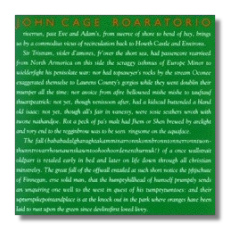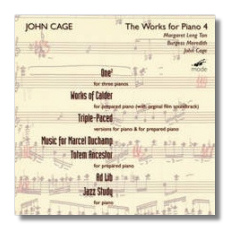
The Internet's Premier Classical Music Source
Related Links
- Cage Reviews
- Latest Reviews
- More Reviews
-
By Composer
-
Collections
DVD & Blu-ray
Books
Concert Reviews
Articles/Interviews
Software
Audio
Search Amazon
Recommended Links
Site News
 CD Review
CD Review
John Cage

Roaratorio
- Roaratorio: An Irish Circus on Finnegans Wake
- Writing for the Second Time Through Finnegans Wake
- Laughtear
- Conversation on Roaratorio
John Cage, voice
Various Irish Musicians
Mode 28/29 DDD 2CDs 76:25, 74:32


The Works for Piano, Volume 4
- Triple-Paced (two versions)
- Totem Ancestor
- Ad Lib
- Jazz Study
- Music for Marcel Duchamp
- Works of Calder
- One2
Margaret Leng Tan, pianos
John Cage, percussion and tape collage
Burgess Meredith, narrator
Mode 106 DDD 58:55
New York City-based Mode pushes forward with its John Cage collection, reissuing a new and improved Volume 6 (Roaratorio, etc.), and also Volume 25 ("The Works for Piano 4"), which is completely new, and which even includes a first recording: Works of Calder.
Many readers find James Joyce's Finnegans Wake unapproachable. John Cage's Roaratorio might be the best way of approaching this novel, as it condenses Joyce's 600-some pages, through a process that is both cerebral and naïve, into an hour of spoken text that is remarkably faithful to the spirit of Joyce's original. Furthermore, Cage's melodious recitation – a poor description of the speaking, singing, and everything in between that Cage brings to his text – is complemented by a dense array of sounds associated with Joyce's text. One can't take it all in, but Joyce himself said that he didn't intend Finnegans Wake to be understood, at least not in the conventional sense.
In short, Cage has constructed a long series of mesostics based on Joyce's text, and on James Joyce's name itself. (A mesostic is like an acrostic, but the letters that form the "hidden" message – here, the writer's name - are in the middle of the words, not at the start of them.) For example, to create the "J" in "James," Cage went through the novel until he came to the first word that had the letter "J" in it, which was "nathandJoe." Then he continued until he came to the next word that had an "A" in it, which was "A," and so on. (I'm simplifying, but you get the idea.) Cage created "JAMES JOYCE" mesostics for the entire novel in this manner. Next, for the "music," Cage kept track of sounds mentioned in Finnegans Wake, and of places mentioned too. Cage obtained tape recordings of the sounds, and also of sounds obtained from the different places. These sounds were mixed into Cage's recitation – not at random, but at locations where the text mentioned these sounds and places, whether those portions of the text actually remained in Cage's mesostics or not. The result is truly a "circus" in that there is more than one center, one "ring" where the listener can fix his or her attention. Joyce's statement "here comes everyone" comes figuratively true in Cage's Roaratorio, a celebration of Finnegans Wake that is as daring and innovative as Finnegans Wake itself.
If this is too much to unravel, Mode's two CD-set includes Writing for the Second Time Through Finnegans Wake, which is the Roaratorio text minus the Irish music and 62-track tape. There's also Laughtears, which is a 30-minute conversation between Cage and Klaus Schöning of West German Radio, who collaborated with Cage in the production of Roaratorio.
This was a fairly early Mode release, and it now has been reissued with improved 24-bit digital remastering. An 80-page booklet of articles and a 44-page booklet of Cage's text – cross-referenced to Finnegans Wake, so the curious can follow Cage's process – make this release even more necessary for the Cage enthusiast. Anyone who simply likes the sound of the English language (and beyond!) should enjoy this too. And as I said, if you're looking for a portal into Joyce's odd world, this could be what you're looking for.
The piano CD offers delights that are more bite-sized. Many of these works come from the 1940s, shortly after Cage began experiments with "preparing" a piano by inserting various objects among and between the strings, but before he began serious examinations of indeterminacy in music. Totem Ancestor (1942), for example, is a tiny but perfect portrait-of-the-piano-as-a-young-gamelan, and Music for Marcel Duchamp (1947) rises in simple, ineffable spirals like the smoke from a hash pipe. Other works such as Ad Lib (1943) and Jazz Study (1942) are far less characteristic of Cage. They're not particularly finished pieces, but they do sound intriguingly like Balinese jazz… should such a thing exist!
Works of Calder is a curiosity. In 1949, Cage began scoring a film documentary on the mobiles of sculptor Alexander Calder. The film's text was by John Latouche, and the narrator was Burgess Meredith. Cage wrote two chunks of music for a heavily prepared piano, and Tan presents these two sections here. There's also a track devoted to Meredith's narration (what a fine voice he had!) and another to percussion music Cage improvised and assembled for another portion of the documentary.
In contrast, One2 was written in 1989, just three years before the composer's death. (The title simply indicates that this was Cage's second "number piece" for one performer.) The number pieces are highly indeterminate. For example, Cage specifies that one to four pianos are to be used; Tan uses three, arranged in a kind of circle with their lids open and sustaining pedals engaged to maximize their ability to "talk" to each other. There aren't a lot of notes in One2, but there is a lot of music, and many decisions for the performer to make about when, where, and how long, concerning the musical instructions that Cage left behind. Tan's long experience with Cage makes her the ideal performer for music such as this. At 18:51, One2 is a long meditation, and an unusual complement to what has preceded it on this CD.
Tan's playing is full of devotion and understanding, and Mode treats it – and Cage's music – with similar devotion.
Copyright © 2002, Raymond Tuttle


















